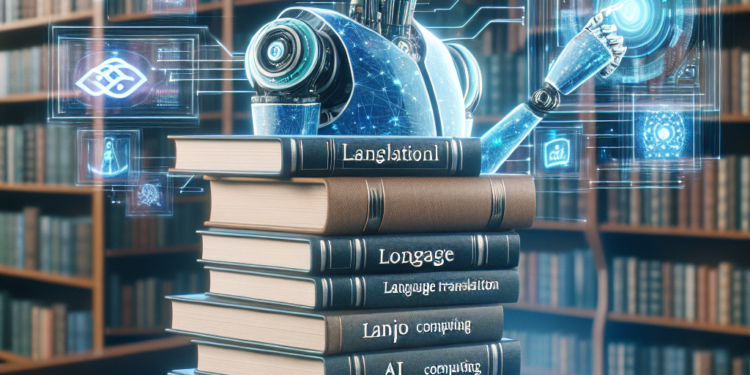Artificial intelligence has become an increasingly important tool in the field of language translation. With the rise of globalization and the need for businesses and individuals to communicate with people from all over the world, the demand for accurate and efficient translation services has never been higher. Thankfully, there are a number of excellent books available that explore the intersection of AI and language translation, offering valuable insights and practical advice for anyone interested in the field. In this article, we will explore some of the top AI books for language translation that every language enthusiast should read.
1. “Natural Language Processing with Python” by Steven Bird, Ewan Klein, and Edward Loper
This book is an excellent introduction to natural language processing (NLP) and how it can be used to improve language translation. The authors provide a comprehensive overview of the field, covering topics such as tokenization, part-of-speech tagging, and syntactic parsing. They also provide practical examples and exercises to help readers apply the concepts they learn. Overall, this book is a must-read for anyone interested in understanding the fundamentals of AI-driven language translation.
2. “Machine Translation” by John Hutchins
John Hutchins is a renowned expert in the field of machine translation and this book is a comprehensive guide to the history, theory, and practice of machine translation. The book covers a wide range of topics, including rule-based, statistical, and neural machine translation, as well as evaluation metrics and applications. Hutchins also provides insights into the latest developments in the field, making this book a valuable resource for anyone looking to stay up-to-date on the latest trends in AI-driven language translation.
3. “Foundations of Statistical Natural Language Processing” by Christopher D. Manning and Hinrich Schütze
Statistical methods are a key component of many modern language translation systems, making this book an essential read for anyone interested in AI-driven language translation. The authors provide a detailed overview of the statistical techniques used in natural language processing, including probabilistic models, sequence labeling, and parsing. They also cover advanced topics such as machine learning algorithms and neural networks, giving readers a comprehensive understanding of how these techniques can be applied to language translation.
4. “Neural Machine Translation” by Graham Neubig
Neural machine translation is a cutting-edge approach to language translation that has revolutionized the field in recent years. In this book, Graham Neubig provides a detailed overview of the principles behind neural machine translation, including deep learning architectures, attention mechanisms, and evaluation metrics. He also covers practical considerations such as data preprocessing, model training, and hyperparameter tuning, giving readers a practical guide to implementing neural machine translation systems. Overall, this book is a valuable resource for anyone looking to gain a deeper understanding of this important technology.
5. “Foundations of Deep Learning for Language Processing” by Chris Dyer, Phil Blunsom, and Yoav Goldberg
Deep learning has become a powerful tool in the field of natural language processing, providing new ways to model complex linguistic structures and improve the accuracy of language translation systems. In this book, the authors provide a comprehensive overview of deep learning techniques, including recurrent neural networks, convolutional neural networks, and sequence-to-sequence models. They also cover advanced topics such as attention mechanisms, reinforcement learning, and transfer learning, giving readers a solid foundation in the principles behind deep learning for language processing. Overall, this book is a valuable resource for anyone interested in harnessing the power of deep learning for language translation.
6. “Language Processing with Perl and Prolog” by Pierre M. Nugues
Perl and Prolog are popular programming languages for natural language processing, making this book a valuable resource for anyone interested in developing AI-driven language translation systems. The author provides a practical guide to using Perl and Prolog for tasks such as tokenization, part-of-speech tagging, and syntactic parsing. He also covers advanced topics such as machine learning algorithms and semantic analysis, giving readers a comprehensive understanding of how these techniques can be applied to language translation. Overall, this book is a valuable resource for anyone looking to develop their own language translation systems using Perl and Prolog.
7. “Language Translation Using Neural Networks” by T. Nagarajan
Neural networks have become a popular tool for language translation in recent years, thanks to their ability to model complex linguistic structures and improve the accuracy of translation systems. In this book, the author provides a comprehensive overview of neural network techniques for language translation, including feedforward neural networks, recurrent neural networks, and convolutional neural networks. He also covers practical considerations such as data preprocessing, model training, and hyperparameter tuning, giving readers a practical guide to implementing neural network-based translation systems. Overall, this book is a valuable resource for anyone looking to understand the principles behind neural network-based language translation.
8. “Language Translation in Parallel Corpora” by Serguei N. Mokhov
Parallel corpora are a valuable resource for training language translation systems, providing large amounts of aligned text in multiple languages that can be used to train machine learning models. In this book, the author provides a comprehensive overview of how parallel corpora can be used for language translation, covering topics such as data preprocessing, alignment methods, and evaluation metrics. He also covers practical considerations such as handling noisy data, domain adaptation, and multilingual text, giving readers a practical guide to using parallel corpora for language translation. Overall, this book is a valuable resource for anyone looking to leverage parallel corpora for training language translation systems.
In conclusion, the field of AI-driven language translation is rapidly evolving, with new techniques and technologies being developed all the time. The books listed above provide valuable insights into the principles behind AI-driven language translation, as well as practical guidance on how to implement these techniques in real-world applications. Whether you are a student, researcher, or practitioner in the field of language translation, these books are essential reading for anyone looking to deepen their understanding of this important and rapidly-growing field.













